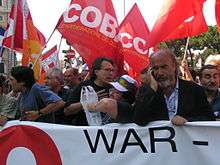Piero Bernocchi

Piero Bernocchi (13 September 1947) is a teacher, trade union officer and an Italian politician.
Biography
Piero Bernocchi was born 13 September 1947, in Foligno, Italy. He participated as a protagonist in the Italian social movements of the 1960s and the 1970s, since the 1968 movement in which he was part of the Coordination team of the Departments of Science, of the Workers’ Committee and as leader of the movement at the Faculty of Engineering, University of Rome.
Among the main representatives of the 77 movement, he was the director of a radio station Radio Città Futura, the first free Italian radio, which was the voice of the Italian movement between 1979 and 1985.
He is the most important representative of the ‘alternative’ trade unionism in Italy, although his activity goes beyond trade unionism. This is because his organization, the Cobas, represents a unique organization that is involved in political, trade unionist, social and cultural initiatives and it rejects any form of separation among them.
He contributed to the creation of the Cobas school unit, which started in 1987. He is still the spokesman of the Cobas school unit and of the Cobas Confederation. The latter includes the following units: School, Health, Public sector and Private sector.
He played a main role in the organization of the World and European Social Forum against the liberal globalization movement starting from the first edition of the World Social Forum (WSF) in Porto Alegre in 2001 and of the European Social Forum (ESF) in Florence in 2002. He is also among the leaders of the ‘noglobal’ Italian movement, which was born in Genoa during the anti-G8 days in July 2001.
He is still one of the most important representatives of WSF and of the ESF and he is a member of the International Council of the WSF.
Bibliography
He has written, among other essays and articles, the following books:[1]
- Le riforme in URSS (contenente anche saggi di Birman, Kantorovic, Leontev, Novozhilov, Omarov), La Salamandra, 1977
- Movimento settantasette, storia di una lotta, [con E. Compagnoni, P. D'Aversa, R.Striano], Rosemberg & Sellier, 1979
- Capire Danzica Edizioni Quotidiano dei Lavoratori, 1980
- Oltre il muro di Berlino. Le ragioni della rivolta in Germania Est, Massari, 1990
- Dal sindacato ai Cobas. Massari, 1993
- Dal '77 in poi, Massari, 1997
- Per una critica del '68. Massari, 1998
- Scuola-azienda e istruzione-merce, AA.VV., Ed. Cesp-Cobas, 2000
- Vecchi e nuovi saperi, AA.VV., Ed. Cesp-Cobas, 2001
- "Un altro mondo in costruzione" (con AA.VV.), Baldini &Castoldi, 2002
- Nel cuore delle lotte Edizioni Colibrì, 2004.
- In movimento (Scritti 2000-2008), Massari, 2008
- Vogliamo un altro mondo. Datanews, 2008
- Benicomunismo, Massari Editore, 2012
- Oltre il capitalismo (Discutendo di benicomunismo per un'altra società), Massari editore, 2015